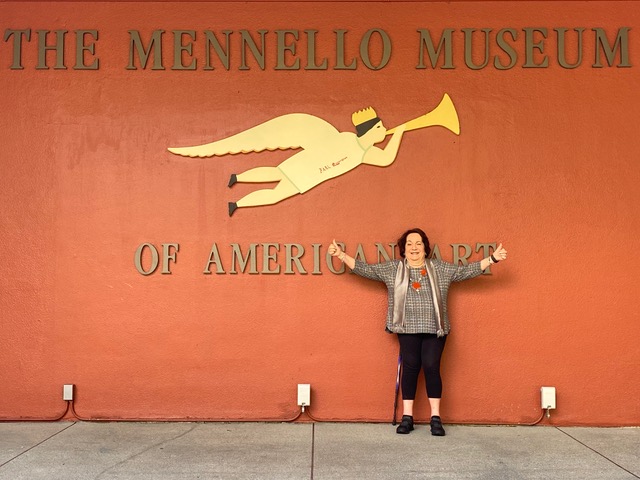Mira Lehr ’56: A Multimedia Artist and Environmentalist Makes Her Mark
Mira Lehr ’56: A Multimedia Artist and Environmentalist Makes Her Mark
Looking solely at her background in art history and early use of conventional media and subjects, those unfamiliar with Mira Lehr’s art might be excused for expecting her to begin her pieces with a contemplative stroke of a brush. But this Miami-based artist’s work is far more likely to start with a bang.

By applying inks to a canvas, then using gunpowder and fuses to create an explosion of color and pattern, Lehr ’56 achieves dramatic and distinctive results, as in “Magenta and Green Mangroves.” The piece is currently on display in High Water Mark, an exhibition of Lehr’s diverse body of work at at the Mennello Museum of American Art in Orlando, FL, through September 2020. Many of the pieces reflect her deep concern about global warming and passionate commitment to preserving the environment. Some of the work is mounted on the walls, but other pieces are immersive, as with the labyrinth of mangroves—constructed primarily from stiffened marine rope—that visitors can walk through, or the video installation of crashing waves that adorn one wall. Suspended from the ceiling, sea creatures float in glassy resin panels.
View a slideshow of Mira Lehr’s work on exhibit through September 2020 at the Mennello Museum of American Art in Orlando, FL. Photos courtesy of the artist.

Lehr’s art has been receiving considerable attention of late, including a half-page article in the New York Times, as well as pieces in Forbes and Artnet, but the artist has been working for more than six decades. Lehr describes herself as “something of a late bloomer” with commercial success not occurring until mid-life, yet her artwork has been exhibited at and collected by prestigious institutions across the country including the Smithsonian, the Getty Museum and Research Center, the Bass Museum of Art, and the Frances Lehman Loeb Art Center. Her work can also be found at a number of American embassies around the world.
Although High Water Mark was in development before the pandemic, Lehr notes a connection between the environmental message conveyed in her work and the current health crisis. “We’ve seen that as people stay home, there’s a change in the use of fossil fuels, the waters have been getting cleaner. It’s absolute proof what our reliance on [this form of energy] is doing to us. Whether people will act on this or not, I don’t know.”
Lehr notes that her awakening to environmental issues began in 1969 with her involvement in the World Game Scenario, a summer-long program led by innovative thinker and inventor, Buckminster Fuller. The forum focused on better use of the world’s resources. Lehr was one of 26 participants selected for the project. “We viewed ourselves as being on this spaceship Earth and talked about how we’re all limited in this finite environment and how we have to treat it as such.”
That awareness has informed her art ever since, but, Lehr adds, “It’s not always the message that is my intention, it’s making the piece function in the way that I want it to, just making the work good.”
Though there was no studio art major when she attended Vassar, Lehr recalls drawing and painting on her own while she majored in art history “working with world class scholars Adolf Katzenellenbogen, Leila Barber, and Agnes Rindge Claflin.” Later, Hans Hofmann and Robert Motherwell were among her mentors.
“I started out working on still lifes from models, using water color and oil. As I became more aware of what I wanted and what I was about, I would change medium and materials, until I became more abstract. Now the work is more pared down to its essence.”
She continued painting while raising a family and credits the support of her late husband, a physician, who readily did his share of caregiving for their children. “He didn’t expect me to follow the so-called women’s routine,” Lehr says. But recognition was not forthcoming during those years, and in 1960 she created the Continuum—a small co-op gallery for women artists in Miami. “If you were a woman and you lived outside of New York City, you were considered a dilettante. So we put on our own shows and were very happy doing the work.”
Today, Lehr is able to devote much of her time to her art, which she creates in her studio at home on the water in Miami, or, when the project involves gunpowder and fire, in her garden. These materials give these works “an edginess, so it doesn’t become too beautiful or too simple,” Lehr says. “You can’t always control what kind of mark it’s going to leave and that’s what makes it exciting. The fuses burn very slowly, making these thorny little segments as they go. The gunpowder explodes all at once [with] a big splash of smoke and fire.
“The neighbors think I’m crazy,” she adds with a laugh.
Lehr’s enthusiasm for experimentation and openness to many kinds of media are also reflected in her use of chalk, Japanese paper, resin, and metals. Her finished projects include textiles and jewelry and on the horizon is a series of prints developed with an Orlando-based studio, Flying Horse Editions.
From all appearances, that exploration will go on indefinitely. “Every so often you make a discovery,” she notes “and it’s the most thrilling thing. And then there are the bad times—when the work is not going well. You have to have enough character to sail through it.”
View this brief video that shows Lehr creating her “explosive” work!